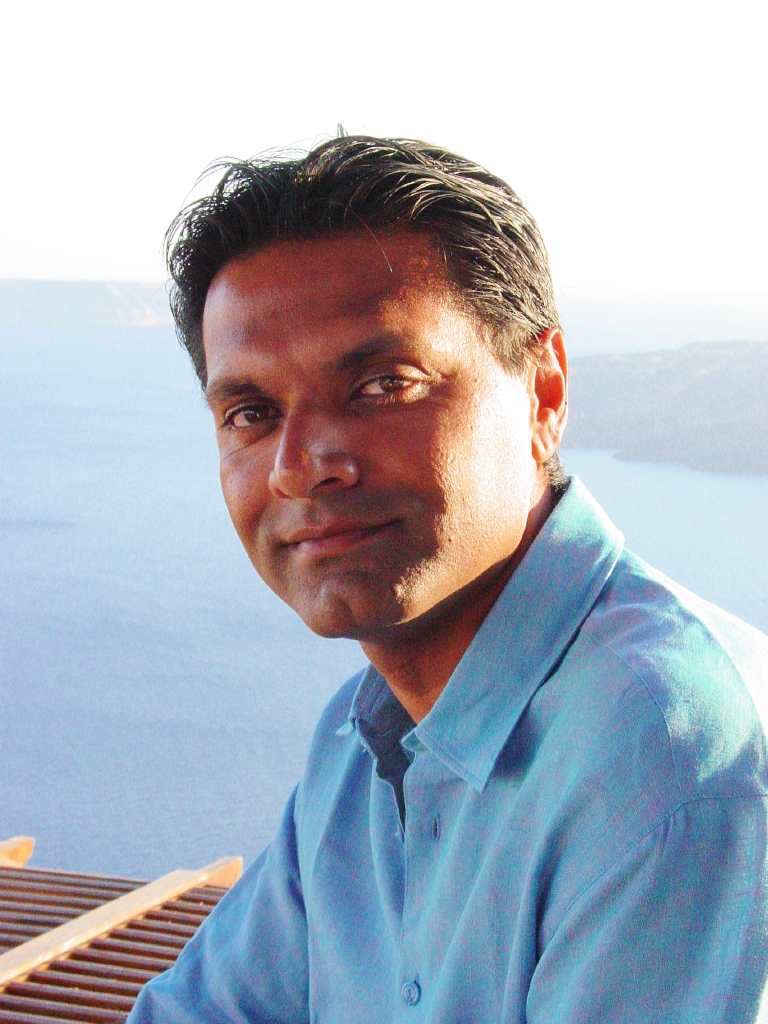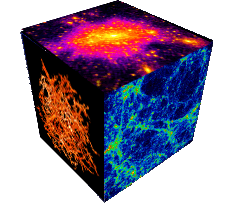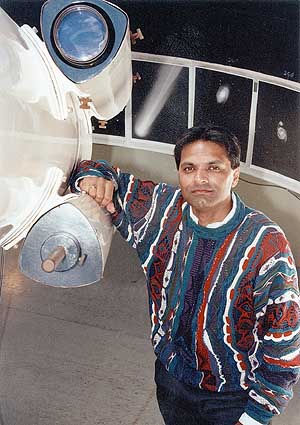
|
"My profession is to be forever journeying, |

|

Arif Babul
 I was recently invited to participate in art exhibition titled "SPHERE". There, as part of an international group exhibition of contemporary explorations of "the sphere" by contemporary artists were two video installations by myself titled "Cosmological Spheres", which made use of actual numerical by two collaborators as part of our larger study on the formation and evolution of structure in the Universe... more The above link will bring up an article published in the March 2006 issue of PI in the Sky magazine. This article had its origins in an exhibition that Dr. Margret Fincke-Keeler, a colleague in the Department of Physics and Astronomy, and I organized in commemoration of the World Year of Physics. The exhibition can be viewed virtually at: |
DESKTOP GALAXIES: COMPUTERS MODEL THE COSMOS Albert Einstein said that the most incomprehensible thing about the Universe is that it is comprehensible. For UVic astrophysicist Dr. Arif Babul, the Universe is more comprehensible each day. In fact, he believes astronomers are on the the brink of explaining the origin of the Universe. Since the beginning of human civilization we have been wondering how the Universe came into being, how life evolved; how it all came together," says Babul. We are living on the threshold of being able to answer those questions. It's a euphoric feeling." Babul researches how our universe evolved from an extremely smooth state into a rich network of galaxies. He describes poetically the texture of the universe, comparing it to to a bejeweled necklace, a spider's web with delicate filaments, or frothy bath ... more Far from being one-dimensional personalities, as popular caricatures would have us believe, scientists are often activists and passionate commentators, engaging in various broader issues that affect society. In my own case, as a practising Ismaili Muslim, my faith serves both as an inspiration to pursue excellence in the intellectual domain - of which science is one facet - and as a reminder that the human existence is richly multifaceted and that one should strive to "experience the Universe" in all its conditions. This notion of "balance" is a key precept of the Ismaili interpretation of Islam. And if this view seems at odds with the popular impressions of Islam, you may want to peruse my following essays: I have, thus far, neglected an important question: Who are the Ismaili Muslims? The Ismailis are the second largest Shia Muslim community who today form a global community that comprises a multiplicity of peoples ranging in their origins from the north-west of the Arab world and the Middle East, through Iran and the Indian sub- continent to Afghanistan, Central Asia and Western China, with subsequent migrations leading to substantial presence in first sub-Saharan Africa and more recently in Europe and North America. The Ismailis are the only Muslim community guided by a living Imam who, within the Shia tradition, is the only rightful inheritor of the Prophet's legacy and authority with regard to ensuring a proper balance between the outward expressions of the faith and its spiritual essence in the face of changing times... more |
 highly organized Universe in which matter is spun into rich web-like chains of galaxies, occasionally punctuated by massive dynamic swarms of up to a thousand bright galaxies held together by their mutual gravity, all woven around giant voids millions of light-years across. Explaining the transition from the smooth beginnings to today's highly organized Universe is one of the Grand Challenges of modern theoretical astrophysics.
highly organized Universe in which matter is spun into rich web-like chains of galaxies, occasionally punctuated by massive dynamic swarms of up to a thousand bright galaxies held together by their mutual gravity, all woven around giant voids millions of light-years across. Explaining the transition from the smooth beginnings to today's highly organized Universe is one of the Grand Challenges of modern theoretical astrophysics.  As dramatic advances in detector and telescope technologies make it possible to observe the Universe at a fraction of it present age, they also bring a sense of urgency to questions that only a few years ago seemed confined to the territory of theoretical speculation. How do cosmic structures form? How do they acquire their observed features?
As dramatic advances in detector and telescope technologies make it possible to observe the Universe at a fraction of it present age, they also bring a sense of urgency to questions that only a few years ago seemed confined to the territory of theoretical speculation. How do cosmic structures form? How do they acquire their observed features? of the corresponding dramatic concentration of galaxies and because they are among the brightest X-ray sournces in the Universe. In addition, the bulk and concentration of dark matter within these systems is so great that the associated gravity is able to bend and distort light of background sources. The blue arcs seen in this picture of a galaxy cluster taken by the Hubble Space Telescope are examples of gravitational lensing.
of the corresponding dramatic concentration of galaxies and because they are among the brightest X-ray sournces in the Universe. In addition, the bulk and concentration of dark matter within these systems is so great that the associated gravity is able to bend and distort light of background sources. The blue arcs seen in this picture of a galaxy cluster taken by the Hubble Space Telescope are examples of gravitational lensing.

